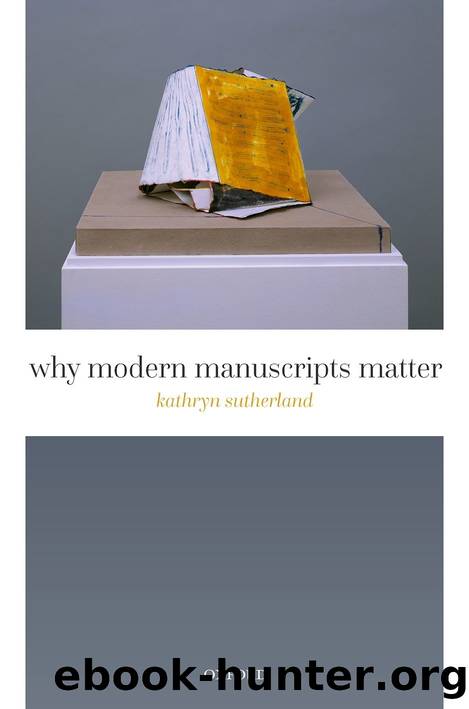Why Modern Manuscripts Matter by Kathryn Sutherland;

Author:Kathryn Sutherland; [Sutherland, Kathryn]
Language: eng
Format: epub
ISBN: 9780192670359
Publisher: OUP Premium
Published: 2022-01-22T00:00:00+00:00
This is still only half the story; equally urgent was Scottâs manufacture of older forms through acts of counterfeit and forgery; what Susan Stewart has described more broadly as the phenomenon of âdistressed genresâ.57 High among âdistressed genresâ are folk tales and ballads, recovered or invented from the eighteenth century by the literary tradition in an attempt to overcome its own idealized distinction between speech (natural) and writing (artificial), between a largely imagined communal production and an autograph literature. Scott served his apprenticeship as ballad collector. Lockhart, writing the life, lay emphasis on his subjectâs untutored beginnings, on a time before he could read or write, when he learnt oral tales by heart. But another version of Scottâs literary origins lies in his so-called âraidsâ into Liddesdale when, in imitation of his border reiving ancestors, he seized the spoils of a common culture, ballads of feuds and skirmishes, and made them his own, forging them in the âantico-modernoâ style advocated by his friend the scholarly romancer George Ellis.58 In reproducing the old ballads, Scott sought proof of âlocality and traditional historyâ as opposed to âmere legendâ.59 Like the fast vanishing oral genres of an imagined previous age, local attachments connote authenticity. From its origins in ballad editing to the aspirations for a posthumous annotated Magnum Opus,60 Scottâs career was shaped by an anxiety to appropriate and stamp his identity on the past seemingly at odds with his games of anonymity.
Scott situated his fables of composition with equal ease in the outside world and within his fictional frames; the ârealâ story of the recovery of the Waverley manuscript is transformed five years later, in the âDedicatory Epistleâ to Ivanhoe, into the imaginary âsingular Anglo-Norman MSâ preserved by Sir Arthur Wardour (a character from Scottâs earlier novel The Antiquary) âwith such jealous care in the third drawer of his oaken cabinetâ. Inventing old manuscripts, losing (and finding) others, Scott aged or âdistressedâ his creations, attaching to them precedence and objectivity; at the same time, he anchored his claim to textual property in something material, substantial, and his own. As late as 1829 and the âGeneral Prefaceâ to Waverley, he felt compelled to inform his reader (quite unnecessarily, after all) that his âoriginal manuscripts are all in existence, and entirely written (horresco referens [âI shudder as I tell itâ]), in the authorâs own handââthe extravagance of the classical allusion (from Virgil, Aeneid, 2. 204) by chance anticipating the mock-terror of Lockhartâs tale of the writing hand in the night. Against this, Scott mired the more abstract labour of creation in false starts and false dates, obscuring the effort of invention behind accidents of recovery and carelessness of design: Waverley, begun âabout the year 1805â, when he âthrew together about one-third of the first volumeâ, was later resumed âwith the utmost carelessnessâ¦I never knew how any chapter was to end at the moment when it was begunâ; even suggesting, in the case of The Bride of Lammermoor, that drugged with pain-killers, he was unconscious of much of its production.
Download
This site does not store any files on its server. We only index and link to content provided by other sites. Please contact the content providers to delete copyright contents if any and email us, we'll remove relevant links or contents immediately.
4 3 2 1: A Novel by Paul Auster(11788)
The handmaid's tale by Margaret Atwood(7447)
Giovanni's Room by James Baldwin(6808)
Asking the Right Questions: A Guide to Critical Thinking by M. Neil Browne & Stuart M. Keeley(5355)
Big Magic: Creative Living Beyond Fear by Elizabeth Gilbert(5351)
Ego Is the Enemy by Ryan Holiday(4956)
On Writing A Memoir of the Craft by Stephen King(4662)
The Body: A Guide for Occupants by Bill Bryson(4580)
Ken Follett - World without end by Ken Follett(4443)
Bluets by Maggie Nelson(4260)
Adulting by Kelly Williams Brown(4232)
Eat That Frog! by Brian Tracy(4149)
Guilty Pleasures by Laurell K Hamilton(4116)
White Noise - A Novel by Don DeLillo(3829)
The Poetry of Pablo Neruda by Pablo Neruda(3814)
Fingerprints of the Gods by Graham Hancock(3733)
Alive: The Story of the Andes Survivors by Piers Paul Read(3730)
The Book of Joy by Dalai Lama(3695)
The Bookshop by Penelope Fitzgerald(3619)
